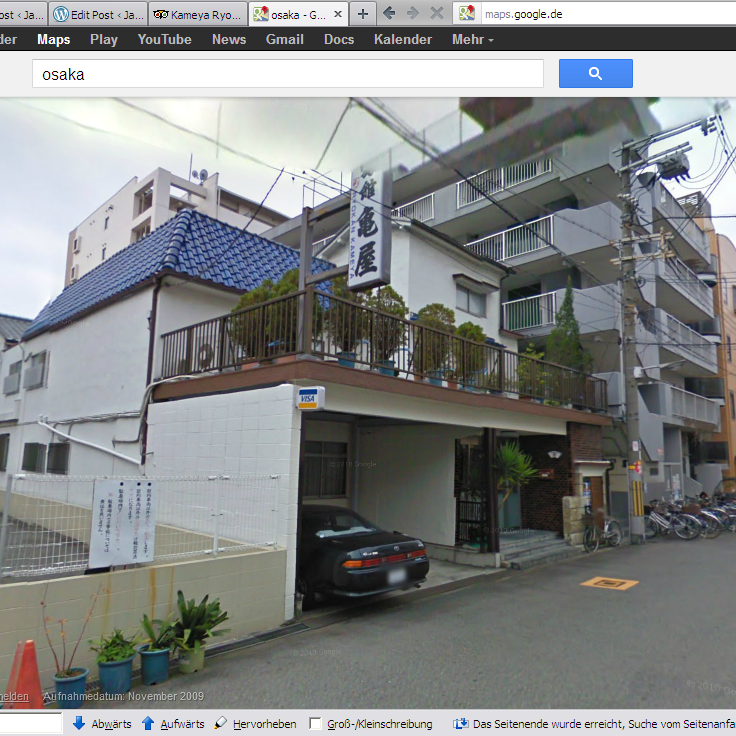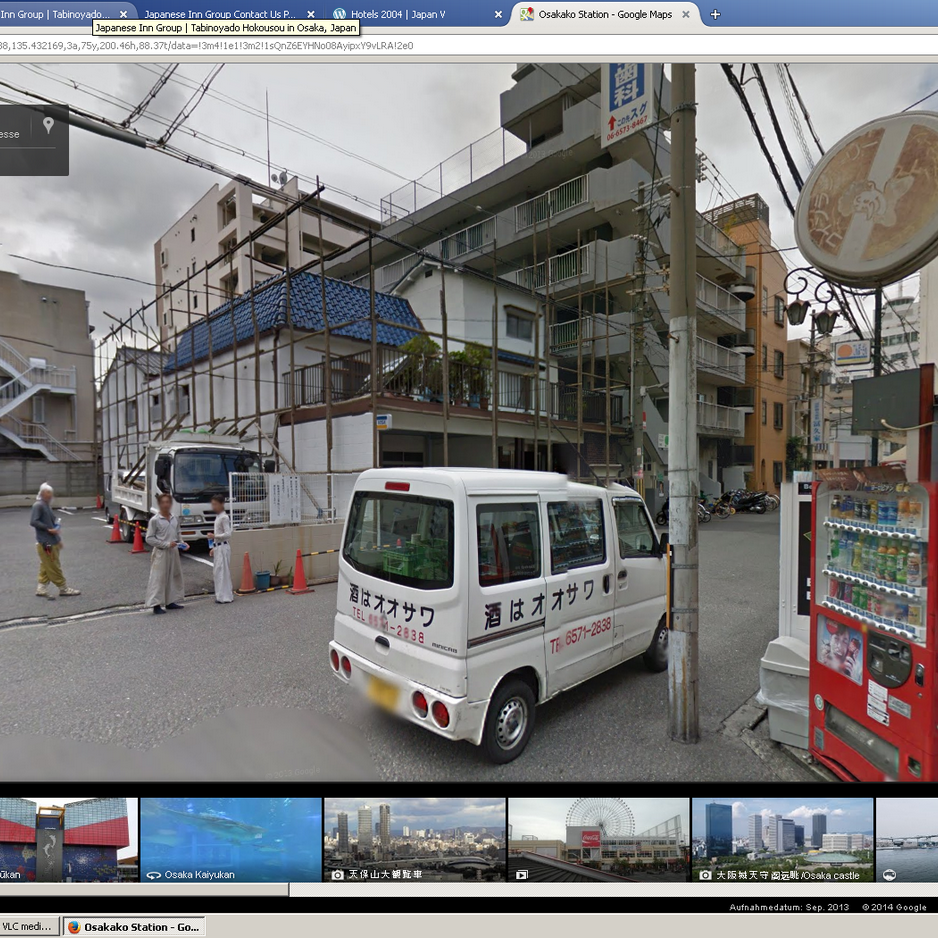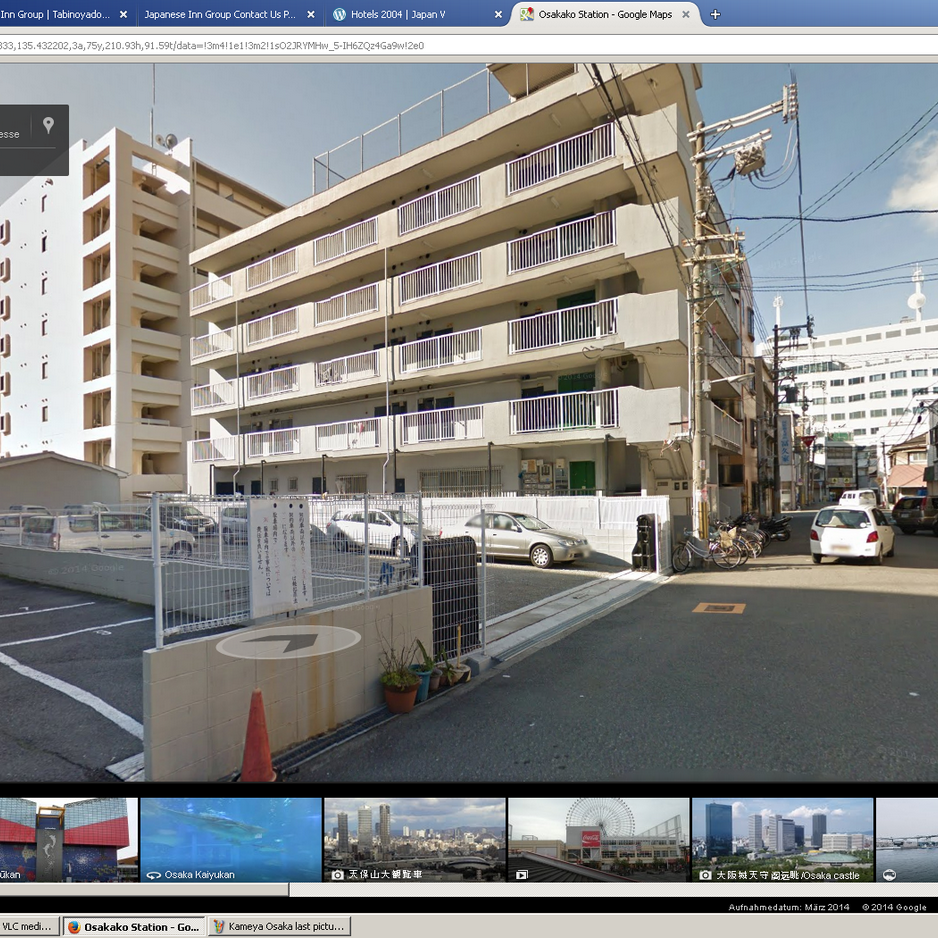Hotel Edoya / ホテル江戸屋
3-20-3 Yushima, Bunkyo-ku, Tokyo, 113-0034 Japan
reserve@hoteledoya.com; phone: +81.3.3833.8751; fax: +81.3.3833.8759
This hotel was my first impression of Japan. It is difficult to describe. I expected something different. But I don“t know what? On the other side, I liked what I found. The japanese room was like I imagined it. And it was big. Only, I discovered the onsen on the roof to late.
The second impression was: The building needs some updates. The taps are old and without power. The carpet in the floor is dead – for several years – and need to be replaced. The toilet room is small the bowl was oddly placed in the middle of the room. I asume that is was a japanese toilet before and the didn“t move the drain pipe. I little bit difficult to get in and out.
But: The hotel was a very good start and a also good finale. There were no complaints from my side. And I will book this hotel again on my next journey. No riscs.
Ryokan Kameya / 亀 屋 旅 館
1-22,4-chome, Chikko, Minato-ku, Osaka 552-0021, Japan
osaka@kameya-ryokan.co.jp; ph: +81.6.6571.0829 ; fax: +81.6.6574.0945;
The Kameye is a small ryokan that is not the newest one. It is run by an older couple. My roome was simple. There only was a common bath room that reminded me of a youth hostel. The ryokan is outside of Oosaka in the area called Oosaka-ko; close to the aquarium and the ferris wheel. On the first view it is not the best area, but I never had trouble, not here or elsewhere in Japan.
The ryokan has the benefit that there is a wash center on the other side of the street. Ok, it is not a center, but there aer public washing machines and no one want to carry around 4 weeks of dirty clothes. And there is the weight limit for your luaggage at the airport too.
Getting There: Like I mentioned, it is located outside the city center. Use the green subway line. If you arrive at Shinosaka by Shinkansen, take the red line first to Hommachi and change there. At Osakako use exit 1 and walk towards the ferris wheel. Turn left into the first side alley. After 50yd there is a small street to the right. The wash center is at the corner. On the left side is the Kameya. It is the building with the blue roof.
[Update 2014: The ryokan does not exist anymore. It was demolished late 2013. On google streetview you can see the ryokan in the pictures from September 2013 and gone in the pictures from March 2014. ]
Hotel Flex / ホテルフレックス
7-1 Kaminobori-cyo, Naka-ku, Hiroshima-shi, Hiroshima 730-0014, Japan
info@hotel-flex.co.jp; phone: +81.82.223.1000; fax: +81.82.223.5678
Hotel Flex is a so called business hotel. I am not sure what the specs of this hotel type are. I asume: a small and functional room with a shower cubicle and no extras (pool, bar). Just a place to stay on a business trip. The price was midrange. If you are only interested in a clean place to sleep, the place is perfect. On trip advisor you will see some negative votes; mostly because of the room size. It is true, the room is small. But it was fine with me. I don’t want to dance a walz.
The hotel has a clear and modern style; with a lot of visible concrete. It everything but traditional japanese. My suggestion for Hiroshima is to stay at Miyajima island and make Hiroshima a day trip. But this is definately not because of the hotel.
Getting There: The location is perfect. It takes a 8 minutes walk from the train station. Leave at the south exit (shinkansen tracks are in the north). Pass the department store and cross the bridge. You will see the hotel on the right side. Turn left after the bridge. After 220yd you cross another bridge. The hotel is the first building on the other side. The entrance can be overseen easily.
Ryokan Nakajimaya / 旅 館 中 島 家
369 Nishimae-cho, Bukkoji, Takakuradori, Shimogyo-ku, Kyoto, 600-8083 Japan; phone: +81.75.351.3886; fax: +81.75.351.3889
The ryokan was like cut out of a flyer. Wow. It is in the center of Kyoto in an small and quiet side alley. It can be topped only be a ryokan in Gion. The ryokan is run by an old couple. It looks like the startet the ryokan after the kids left the house. It was like visiting your grandpararents. It was awesome.
Getting There: Take a taxi or use the subway for two stations. You don“t want to walk the way (1,5 miles). With the heavy luaggage it was no joke. From Kyoto station follow the Karasumadori to the North. The broad street will pass the eastern temple. The subway is underneath the road. At subway station Shijo find exit 5. Turn right into Bukkojidori. The street can easily been overseen. After 110yd there is a street cross. Go straight. After another 110yd there is a street to the left, Takakuradori. Go into the street. The ryokan is after 50yd on the left side.
http://www.youtube.com/watch?v=aWDMFdUHiDE
p.s.: I found a video on youtube that shows the street and the ryokan. The video shows a typical resident area in Kyoto. The tour starts north of the ryokan.
Uotoshi Ryokan / 魚 敏 旅 館
2563, Sano, Yamanochi-Town, Shimo-Takai-Gun, Nagano, 381-0402 Japan
miyasaka@avis.ne.jp; phone: +81.269.33.1215; fax: +81.226.33.0074
The Uotoshi is ryokan of the low price section. Who read my blog knows, that the building needs a painting job. The dog that annoyed me should be gone (we have 2010). The benefit of this ryokan is the real onsen. The owner was very helpful during my whole stay. He drove me to the bathing snow monkeys and to the train station. He also gave me the advise to visit the 9 public onsen in the neighbor town (that was awesome). And he is doing Kyodo and is good.
Getting There: Starting at the station follow the street downhill. At the bottom the street does a right turn. Follow the street stragiht ahead across the river. At the end of the street there is a big hotel. To the right is a smaller building. That’s the Uotoshi. In total it is a half mile.
Ryokan Bentenkaku / 旅 館 弁 天 閣
87 Kurumayu, Naruko-onsen, Osaki-city, Miyagi-ken, Japan
n-info@bentenkaku.jp; phone: +81.229.83.2461; fax: +81.229.83.4259
This ryokan is more like a hotel. It is hard to categorize because there is no line.
Getting There: The ryokan is at the end of the town. It is a one mile walk from the train station Narukoonsen. Get a taxi. An alternative route is to get of a station earlier (Narukogotenyu). From there it is a little more than a half mile.
From Narukoonsen follow the street thru the town (train tracks on the left). The street ends at highway 47 that is running parallel. Follow the highway. The ryokan is behind the petrol station.
Starting in Narukogotenyu follow the street down from the station to the highway 47. Follow the highway to the left. On the left side is the hill. After a quarter mile the ryokan is the first building on the left.
–== Deutscher Blogeintrag ==–



